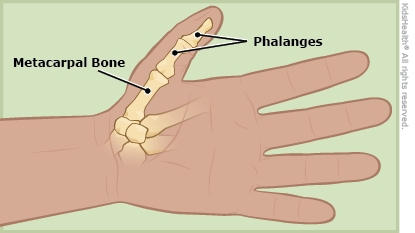A broken thumb means one or more of the bones in the thumb has a fracture (crack). A cast keeps the broken bone from moving while it heals. Taking good care of the cast and treating pain will help keep your child comfortable during healing.

Follow your health care provider's recommendations for:
- Caring for the cast
- What activities to avoid (such as sports and gym class)
- Coming to all follow-up appointments
To decrease swelling:
- Prop up the hand on pillows when your child is sitting down or sleeping.
- Remind your child to wiggle the uninjured fingers to keep blood circulating normally.
If your child has pain:
- Put ice in a plastic bag wrapped in a towel on the outside of the cast for 20 minutes every 3 hours. Don't put ice directly on the cast or skin.
- If your health care provider says it's OK, you can give acetaminophen (Tylenol® or a store brand) or ibuprofen (Advil®, Motrin®, or a store brand). Follow the package directions for how much to give and how often. Don't give ibuprofen to babies under 6 months old.
- Help your child get their mind off the pain by:
- Doing something they enjoy such as reading a book or watching a show together
- Playing relaxing music
Daily cast care:
- Check the area around the cast every day. Make sure the skin isn't scratched and the thumb isn't pale, blue, numb, or tingling.
- Check the edges of the cast. Make sure your child isn't picking at or removing the padding from the edges or breaking off any parts of the cast.
- Don't put anything in the cast. Make sure your child doesn't put toys, food, or other objects into it.
- Keep dirt, sand, lotion, and powder away from the cast.
Keep the cast dry:
- No swimming.
- You can give younger children a sponge bath. For regular baths or showers, you can cover the cast with one of these:
- Two plastic bags sealed at the top with a rubber band (or tape)
- Plastic wrap covered with a plastic bag that is sealed at the top
- A waterproof cast protector
- If the cast gets splashed, blow air into it from a hair dryer on the cool setting.
Problems to watch for:
- Sharp cast edges: Put tape or moleskin (available at drugstores) on any rough spots.
- Itching: Tap lightly on the cast or use a hair dryer on the cool setting to blow air in and around the edges. Never use an object to scratch under the cast.
- Swelling: If the fingers near the cast look puffy, raise your child's arm above the level of the heart for 1 hour. If the swelling doesn't get better, call your health care provider.

Your child's thumb gets more swollen, changes color, or is cold, numb, or tingly.

How long will it take a broken thumb to heal? Most broken thumbs need a cast for 4–6 weeks. Your child will have one or more follow-up visits with the orthopedic specialist (a health care provider who specializes in bone care). During these visits, the specialist will check to make sure the thumb is healing well.
When can my child return to sports? The orthopedic specialist will tell you when it's OK for your child to return to sports activities. After the cast comes off, your child may need to wear protective hand gear or tape the thumb for sports for a few weeks — or possibly longer.




